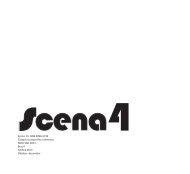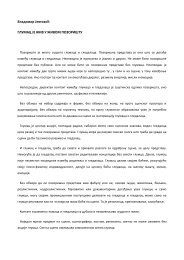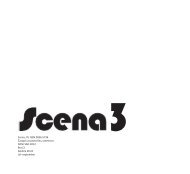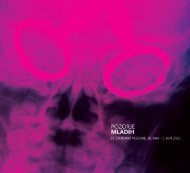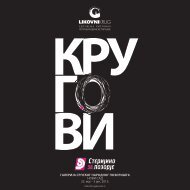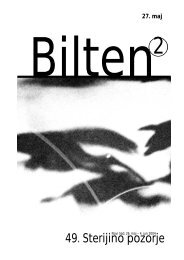Zoja Buzalkovska The Creative Conflict between Stanislavski and ...
Zoja Buzalkovska The Creative Conflict between Stanislavski and ...
Zoja Buzalkovska The Creative Conflict between Stanislavski and ...
Create successful ePaper yourself
Turn your PDF publications into a flip-book with our unique Google optimized e-Paper software.
<strong>Zoja</strong> <strong>Buzalkovska</strong><br />
<strong>The</strong> <strong>Creative</strong> <strong>Conflict</strong> <strong>between</strong> <strong>Stanislavski</strong> <strong>and</strong> Meyerhold<br />
<strong>and</strong> a Possible Fusion of <strong>The</strong>ir Systems<br />
1. INTRODUCTION<br />
It has been exactly 120 years since V.E. Meyerhold first left the Moscow Art <strong>The</strong>atre (MAT) <strong>and</strong><br />
started working on something which was soon to seriously challenge the system of K.S. Stanislavki in regard<br />
to the method of working with actors <strong>and</strong> an actor’s work on himself <strong>and</strong> his role. Interestingly enough, to<br />
this day Meyerhold has remained to be seen as avant-garde, mysticism, extreme by theatre theoreticians,<br />
while his approach is taken as something that is good to know, but would better be avoided when working<br />
on a play. This opposition to his system has particularly been evident on the Russian theatre scene, where<br />
‘<strong>Stanislavski</strong>an’ method of work still prevails in the theatre, while ‘Meyerholdian’ is proclaimed – an<br />
experiment, a sketch which has never been actually implemented in theatrical language <strong>and</strong>, therefore,<br />
should perhaps remain a museum treasure <strong>and</strong> set in the past of Russian avant-garde <strong>and</strong> the great utopia<br />
of the Russia of the 1920’s. Unrelated to this subtle war, in the late 1980’s the academic subject of<br />
Biomechanics was included into the curriculum of the GITIS (the major national theatre academy with a<br />
great international reputation in Moscow, today’s RATI), Valery Fokin opened the Meyerhold Centre in<br />
Moscow, professors <strong>and</strong> directors such as Pyotr Fomenko <strong>and</strong> his successors, Ivan Popovski among others,<br />
extended Meyerhold’s thought <strong>and</strong> implemented it in their work in various ways, while an extensive<br />
literary opus <strong>and</strong> all the writings <strong>and</strong> letters associated to Meyerhold’s work have been published in the last<br />
thirty years with a great support of the Meyerhold Museum.<br />
Nevertheless, even 120 years after the first steps Vsevolod Emilevich took away from his teacher<br />
<strong>Stanislavski</strong> (as he would emphasise regardless of the fact that his formal professor was Nemirovich-<br />
Danchenko) <strong>and</strong> <strong>Stanislavski</strong>’s underst<strong>and</strong>ing of acting <strong>and</strong> work with actors, even some 80 or 90 years<br />
after his writings, lectures, recorded instructions <strong>and</strong> notes during the process of working on the play ‘<strong>The</strong><br />
Inspector General’ <strong>and</strong> on his other plays, <strong>and</strong> 70 years after his death, the progressive <strong>and</strong> avant-garde<br />
thought of Meyerhold’s expression still struggles against the deeply rooted, entrenched practice of<br />
psychological realism, the theatre of experiencing, the feeling of truth <strong>and</strong> belief in the theatre, the play ‘as<br />
in life’. It struggles while working on plays in theatres, it struggles during the acting lessons at faculties of<br />
dramatic arts, it struggles with the nature of every actor who better underst<strong>and</strong>s <strong>and</strong> more easily adopts<br />
the <strong>Stanislavski</strong> method (in our opinion, a very absurd phenomenon), it struggles with audiences, who are<br />
presented with dem<strong>and</strong> for a more committed engagement by the Meyerhold <strong>The</strong>atre, <strong>and</strong> which they are<br />
not always willing to fulfil.
<strong>The</strong> practices of <strong>Stanislavski</strong> <strong>and</strong> Meyerhold started from the same point, the same source of love<br />
for the theatre <strong>and</strong> the same absolute dedication, as well as the engaged thinking <strong>and</strong> conceptualization of<br />
the work in the theatre, only to bifurcate, becoming two antipodes, two polar ends of the scope in the field<br />
of work with an actor, thus becoming perhaps the quintessential contrast <strong>between</strong> the ‘presence’ <strong>and</strong><br />
‘representation’ of an actor. All other approaches <strong>and</strong> techniques are, one could dare say, (mere) variations<br />
of these theatre system antipodes. Hence, it seems particularly important to try to develop this thesis<br />
based on their example.<br />
Despite all misunderst<strong>and</strong>ings, open criticism, occasional rejoining <strong>and</strong> collaboration followed by<br />
new departures <strong>between</strong> <strong>Stanislavski</strong> <strong>and</strong> Meyerhold, it seems that the system of Vsevolod Emilievich<br />
would have never been able to develop, had it not been provoked by its own foundation, the system of<br />
Konstantin Sergeyevich. Furthermore, the <strong>Stanislavski</strong> system, as well as some of his later thoughts <strong>and</strong><br />
observations on the theatre, testifies that he revisited his earlier rigid positions, which could be related to<br />
the theory <strong>and</strong> practice of Vsevolod Meyerhold. <strong>The</strong> point of serious divergence of these two systems is the<br />
work with actor, or, more accurately, the answer to the questions of where <strong>and</strong> how an actor’s creation<br />
starts, what it seeks out, <strong>and</strong> when it reaches the point of its completion in the process of working on a<br />
role.<br />
It seems that despite the fact that the road to the role in <strong>Stanislavski</strong>’s system leads from the inside<br />
outwards, quite on the contrary from Meyerhold’s system, which is directed from the outside inwards, both<br />
systems have a common goal. That is why something that, perhaps, seems impossible at first sight should<br />
be done - an attempt at a fusion of these two systems into one, new, which would create a true balance of<br />
‘presence’ <strong>and</strong> ‘representation’, using the strongest positions of both approaches, <strong>and</strong> jettisoning<br />
everything that many years of practice have proved insufficiently useful, <strong>and</strong>, moreover, harmful for the<br />
actor, crew, the director’s work <strong>and</strong> the final result of a play.<br />
However, to reach that point, we first have to look at the question of what constitutes the<br />
opposition in conceptualising the theatre <strong>and</strong> the actor in these two antipodean systems?<br />
2. ESSENTIAL POSITIONS OF THE STANISLAVSKI SYSTEM<br />
For Konstantin Sergeyevich <strong>Stanislavski</strong>, an act of the theatre should mirror the reality in the<br />
theatre. Speaking sharply against representation <strong>and</strong> imitation in the theatre, he bases his system on the<br />
‘art of experiencing’, which he describes in the following way:<br />
Certain aspects of the human psyche obey the conscious mind <strong>and</strong> the will, which have the<br />
capacity to influence our involuntary processes. True, this dem<strong>and</strong>s long, complex creative
work, which only proceeds partially under the direct guidance <strong>and</strong> influence of the<br />
conscious mind. It is, for the most part, subconscious <strong>and</strong> involuntary. Only one artist has<br />
the power to do it, the most discriminating, the most ingenious, the most subtle, the most<br />
elusive, the most miraculous of artists – nature. Not even the most refined technique can be<br />
compared to her. She holds the key! This attitude, this relationship to nature absolutely<br />
typifies the art of experiencing.<br />
(<strong>Stanislavski</strong>, 1982, 158)<br />
This formulation already shows where the hidden danger of this system lies <strong>and</strong> displays its great<br />
intangibility. <strong>The</strong> partial control <strong>and</strong> incomplete influence of the conscious on the unconscious mind open,<br />
at the very beginning, the door to an unguaranteed, always changeable result, where every action of the<br />
actor is a hostage to the incomprehensibleness of his organic nature. On the one h<strong>and</strong>, his system<br />
undoubtedly brought a breath of fresh air into theatre <strong>and</strong> stripped it off a layer of artificiality,<br />
pretentiousness, theatricality <strong>and</strong> overplaying, but on the other, it is a system deeply buried into the<br />
actor’s psychology <strong>and</strong> challenged or negated for this very fact. That is why we take with caution his<br />
explanation of the conscious ways for affecting the unconscious.<br />
<strong>Stanislavski</strong> advocates: ‘Subconscious creation through the actor’s conscious psychotechnique. (<strong>The</strong><br />
subconscious through the conscious, the involuntary through the voluntary.)’ (<strong>Stanislavski</strong>, K. S. 1982, 26)<br />
One should create credibly, <strong>and</strong> ‘that means thinking, wanting, striving, behaving truthfully, in a logical<br />
sequence, in a human way, within the character, <strong>and</strong> in complete parallel to it. As soon as the actor has<br />
done that, he will come close to the role <strong>and</strong> will begin to feel as one with it.’ For him, the art of the theatre<br />
is ‘the creation of the life of a human spirit in a role <strong>and</strong> the communication of that life onstage in an artistic<br />
way’, while, ‘bringing our own individual feelings to it, endowing it with all the features of our own<br />
personality.’ (<strong>Stanislavski</strong>, K. S. 1982, 27)<br />
By conscious psychotechnique, <strong>Stanislavski</strong> means <strong>and</strong> suggests his magic ‘If’, Given Circumstances,<br />
Bits <strong>and</strong> Tasks <strong>and</strong> their definition with nouns <strong>and</strong> verbs, even the formulation of Tasks in order to set will<br />
into motion, with a suggested ‘I am being...’. ‘To offer one’s h<strong>and</strong> to yesterday’s enemy is not simple by any<br />
means, <strong>and</strong> needs a lot of forethought <strong>and</strong> feeling. A Task of that kind can be qualified as psychological, <strong>and</strong><br />
is quite complicated,’ (<strong>Stanislavski</strong>, K. S. 1982,149) – he says, giving an example of psychological torture<br />
which can be imposed on the actor, because when he is given a Task that is ‘psychological’, he must set his<br />
subconscious mind in motion in just a few seconds <strong>between</strong> an extended h<strong>and</strong> of his enemy <strong>and</strong> his own<br />
decision to respond by reaching back, before he starts experiencing double mind, hatred, love, breaking,<br />
conscience, reconciliation, capacity to forgive, dignity, hesitancy, etc.
One of the key positions of Konstantin Sergeyevich’s school is Emotional (Affective) Memory which<br />
helps the actor to fully accomplish his art of experiencing. <strong>Stanislavski</strong> says that such experiencing should<br />
be achieved at every performance of a play, setting in motion <strong>and</strong> recalling the same feelings every time it<br />
is repeated. But, the question is how to achieve this? <strong>Stanislavski</strong> himself, in a later stage of his work, wrote<br />
down in his notes:<br />
What is distasteful in the actor’s self-feeling? <strong>The</strong> first time you experience the feeling in a<br />
fresh, pure way, intrinsically. By repeating it dozens of times, the pure affective feeling starts<br />
merging with Emotional Memory of the onstage experience of the same feeling. <strong>The</strong>n, the<br />
feeling is polluted, poisoned <strong>and</strong> first loses some <strong>and</strong> later all of its directness <strong>and</strong> natural<br />
purity <strong>and</strong> resilience. Finally, what remains is a stage memory.<br />
Notes from Book No. 3319, l.10"<br />
(Станиславский, 1986, II, 10)<br />
Everything done onstage without an inner justification, for <strong>Stanislavski</strong> is mechanical, since it does<br />
not come as a result of the real life of imagination.<br />
But, on the other h<strong>and</strong>, <strong>and</strong> contrary to many who think that Konstantin <strong>Stanislavski</strong> in his system<br />
absolutely neglects the aspect of work with the body, he emphasises that the delicacy of subconscious life<br />
cannot be expressed without exceptionally responsive <strong>and</strong> outst<strong>and</strong>ingly well-trained vocal <strong>and</strong> corporal<br />
apparatus, as voice <strong>and</strong> body provide a means to convey almost imperceptible inner feelings. (<strong>Stanislavski</strong>,<br />
K. S. 1982, 29) However, we must emphasise that this by no means implies that the actor should take body<br />
for his starting point in work, but that body will gradually find its form, the accurate gesture will find its true<br />
expression, <strong>and</strong> voice its most powerful timbre once the inner life of the actor has reached the level of<br />
development which enables him to embody these external manifestations of experiencing. Thus, bodily<br />
expression becomes a symptom of whatever happens in the actor’s soul that he lends to the character he<br />
interprets.<br />
One of the greatest pitfalls of this system in the creative sense is the repetition of the actor in every<br />
subsequent role, regardless of the text he is uttering or character he is developing. Giving the material of<br />
his soul to the character, experiencing instead of representing, seeking always to commit himself <strong>and</strong> his<br />
emotional memory to his work, the actor starts being recognisable, but later becomes someone who<br />
reappears in every role <strong>and</strong> who plays Hamlet, Ivanov <strong>and</strong> Orestes in a very similar way.
3. ESSENTIAL POSITIONS OF MEYERHOLD’S SYSTEM<br />
Quite on the contrary, the system of V.E. Meyerhold, from the very beginning to the tiniest of<br />
details involved in working with actors, is primarily focused on what the stage action looks like. That is, not<br />
WHAT <strong>and</strong> WHY, but much more – HOW.<br />
Meyerhold advocates pure play, efficiency of movement, bright visual expression, with intonations<br />
<strong>and</strong> finding a particular tone of voice, the auditory potential of words. For him, the segment of rhythm <strong>and</strong><br />
tempo of movement <strong>and</strong> speech are of utmost importance. He sees a play as a musical score. He insists<br />
that the actor has to develop an awareness of his own self onstage. ‘<strong>The</strong> actor’s work – it means to be able<br />
to perceive oneself onstage. One should get to know his body, in order that he knows exactly what it looks<br />
like when he takes a certain position,’ (Meйерхольд, 1998, 46) – he says in the first item of his acting<br />
lesson, the lesson consisting of forty-one items <strong>and</strong> can certainly be named the ACTING MANIFESTO today.<br />
<strong>The</strong> actor will gain an absolute control over his body if he combines rhythmic <strong>and</strong> general gymnastics in his<br />
work <strong>and</strong> if he even succeeds in being able to hear with every part of his body. Vsevolod Emilevich is not<br />
interested in anatomy, but the exploration of body as a material for stage play. In the ninth item of his<br />
‘manifesto’, he emphasises the importance of playing with perspective, that is, the idea of changing the<br />
position of body onstage, playing with what is visible to audience <strong>and</strong> can be hidden from them at a certain<br />
point.<br />
To prepare an actor for this kind of theatre, Meyerhold suggests <strong>and</strong> does biomechanic exercises.<br />
<strong>The</strong>y heavily rely on the laws of balance. <strong>The</strong> actor has to have such a comm<strong>and</strong> of his body to be able to<br />
quickly find the point of balance at any given moment. In one of his lectures, given on 12 th June 1922, he<br />
defined biomechanics: ‘Biomechanics attempts to, in an experimental way, determine the laws of stage<br />
movement, <strong>and</strong> create exercises for actors’ training based on the norms of human behaviour.’(Meyerhold,<br />
1976, 169) Through these exercises the actor extends the possibilities of his work with body, which<br />
becomes cultivated, he develops an awareness of how to make his body visually most effective, as well as<br />
an ability to emphasise certain actions so that his body becomes visible in its full accuracy of nuanced<br />
actions. But, at the same time, Meyerhold warns: ‘<strong>The</strong> technique of an actor, who has not lived through the<br />
spectrum of life, can lead him to the irrelevant circus acrobatics.’ (Meйерхольд, 1998, 47)<br />
Speaking about the actor’s play, Meyerhold opens a question of reflective excitement <strong>and</strong><br />
compares the road to reaching or starting such excitement in systems of play with ‘inside’ <strong>and</strong><br />
‘experiencing’. In the case of the former, it is achieved ‘through artificial excitement of the previously<br />
weakened feeling’, <strong>and</strong>/or ‘by systematic narcosis (alcohol, cigarettes, narcotics)’, <strong>and</strong> in the latter, through<br />
‘enforcing a feeling with hypnotic tension of previously weakened will.’<br />
This leads us to the crucial proposition of his work with the actor. This is how Vsevolod Emilevich<br />
explains his system of work:
"26. Principles of biomechanical perspective upon human nature should be placed at the core<br />
of the acting system. In this sense, cultivation of excitement (an ability to reproduce a given task<br />
in emotions, in movement <strong>and</strong> in words) in actors is carried out in such a way to enable mental<br />
processes to be a result of physical virtue.<br />
27. Biomechanical system of play is based on the accurate appearance of excitement caused<br />
by the correct position of the actor in space. At the same time, each moment the motion will be<br />
associated with a precise relationship to all the other surrounding characters <strong>and</strong> objects.<br />
29. <strong>The</strong> material of the actor’s art is the actor himself. <strong>The</strong>refore, we have in one person the<br />
material <strong>and</strong> its constructor...<br />
30. Each <strong>and</strong> every element of acting is necessarily (vitally) composed of three invariable<br />
phases:<br />
INTENTION, REALISATION AND REACTION<br />
INTENTION – is the intellectual assimilation of a task prescribed externally (by the dramatist,<br />
the director, or the initiative by the performer).<br />
REALISATION – the cycle of volitional, mimetic reflexes (comprise all movements performed<br />
by the separate parts of the actor’s body <strong>and</strong> the movements of the entire body in space) <strong>and</strong><br />
vocal reflexes;<br />
REFLEX EXCITABILITY – is to reduce to the minimum the process of underst<strong>and</strong>ing the task<br />
(simple reaction time)<br />
31. It is the very excitement that makes the difference <strong>between</strong> an actor <strong>and</strong> a marionette,<br />
that which enables the actor to infect the spectator <strong>and</strong> cause his counter-excitement. This<br />
counter-emotion which comes from the spectator at the same time feeds, fuels the continuation<br />
of play (state of ecstasy.)’<br />
(Мейерхольд, 1998, 47-48)<br />
It is important to reemphasise the tendency to reduce means of expression, where the actor uses<br />
only movements <strong>and</strong> gestures which are sufficient to send a message to the spectator. Moreover,<br />
movements need to be rationalised to reduce the actor’s fatigue, which increases his fitness <strong>and</strong> expressive<br />
power.<br />
It is clear in the first volume of the book ‘Meyerhold Speaks/Meyerhold Rehearses’ what Vsevolod<br />
Meyerhold is interested in when working with actors. Some of the indications he gives to the actors while<br />
working at the anthological production of ‘<strong>The</strong> Inspector General’ are:
... If in ‘Rogonosac’ I worked more on rakurses, here in ‘<strong>The</strong> Inspector General’ we will focus<br />
on the play with h<strong>and</strong>s... For this play, it is very important to observe our h<strong>and</strong>s...<br />
<strong>The</strong>re are no heightened tones. Words pour, pour out – without changes. You’re raising your<br />
voice to no avail. A little higher in baritone register, a little nasal. In one tone, there is almost<br />
no intonation. Monotonous, terribly monotonous...<br />
... Hlestakov, go much slower, much slower...<br />
... Ivan Alex<strong>and</strong>rovich, you should lower it fast, so that the whole scene is immediately lower<br />
in regard to sound... <strong>The</strong> play is going, <strong>and</strong> the tonality is not that.<br />
... It is better that all movements are with body, not h<strong>and</strong>s. When you move on to<br />
gesticulation, the head movement will be lost...<br />
... Our biomechanical laws say: there should be no gesture made, if I don’t st<strong>and</strong> in the spot.<br />
Stoppage – left leg <strong>and</strong> right arm. When the leg is bent – rakurs is good, when the leg is<br />
straight – it is not artistic.’<br />
4. DIFFERENCES BETWEEN THE ANTIPODEAN SYSTEMS<br />
(Ситковецкая и Фельдман, 1993, 101 - 147)<br />
In one of his books of notes from the later period, somewhere around 1912, <strong>Stanislavski</strong> writes:<br />
My system will be criticised for trying to expel conditionalities, stencils from art, since it<br />
believes that all that is conditional – is not art, but craft. But all other stagecraftsmen will<br />
not acknowledge the beauty of nature, but they acknowledge the beauty of the very ugly<br />
matrix. To devaluate my viewpoints they will surely call me a realist, naturalist, etc. <strong>The</strong>y will<br />
say that I am a photographer, because I am involved in the greatest beauty – nature, <strong>and</strong><br />
they are refined men of culture, because they work with the most perfect of nature’s copies<br />
– with actorial conditionality <strong>and</strong> stencil. No, I reject no schematisations, nor stylisations,<br />
nor many other ‘...ations’ yet unborn, but I will set one condition. Let these ‘...ations’ live in<br />
the soul of the one who does them.<br />
Note from the book no. 981, l.12 "<br />
(Станиславский, 1986, II, 8-9)<br />
This note clearly shows the kind of opposition to his system he faced with <strong>and</strong> what exactly he had a need<br />
to defend. One of the people he makes an allusion to in this <strong>and</strong> other notes of similar content is<br />
Meyerhold himself, who, in his public appearances, claims that <strong>Stanislavski</strong>’s method is harmful to the<br />
psycho-physical health of the actor. <strong>The</strong> hypnotic triggering of the unconscious in <strong>Stanislavski</strong>’s System
ecomes psychological torture for the actor in search of spontaneity, which, quite contradictorily, often<br />
leads him into spasm, contrary to Meyerhold’s ‘intention-realisation-reaction’, which is essentially, <strong>and</strong><br />
quite contradictorily again, much more natural. By calling into question the control of an actor who is<br />
overwhelmed by emotions, Meyerhold explains his position in the following way:<br />
Any psychological state is conditioned by certain physiological processes. By finding the<br />
correct solution for his physical state, the actor enables a situation of excitability which<br />
infects the spectator, involves him into the actor’s play <strong>and</strong> represents the essence of his<br />
play... With such a system of appearing feelings, the actor always has a solid ground: a<br />
physical precondition.<br />
(Meyerhold, 1976, 168)<br />
Meyerhold’s way is more difficult in regard to adopting the technique, but it is safer for the actor<br />
<strong>and</strong> the final result. <strong>The</strong> actor’s orientation from the inside outward certainly does not vouch for<br />
manifestation of the correct gesture, facial expression, particular way of speech <strong>and</strong> in general, the<br />
construction of a character in the direction of a complete transformation. <strong>The</strong> actors who use <strong>Stanislavski</strong>’s<br />
system in its original form or translated to the language of the American theatre in several different<br />
versions (Strasberg, Adler, Luis, Meisner), with emphasis on ‘believing’ or ‘doing’, nevertheless, cannot be<br />
sure that they have always acted what they have intended to, with domination of privacy <strong>and</strong> repetition of<br />
expressive means. This is so because the system is based on psychology, which, as Meyerhold warns,<br />
‘cannot provide a definite answer to a whole number of questions.’(Ibid.)<br />
An actor who is overwhelmed by panic onstage can be compared to a cyclist who has lost self-<br />
confidence. In a calm state the cyclist probably knows that the instinct of self-preservation will<br />
save him. Yet, when losing balance, it is necessary to turn the h<strong>and</strong>lebars to hold both himself<br />
<strong>and</strong> the bicycle in vertical position.<br />
But the damned nervousness <strong>and</strong> fear can unarm the most powerful habit of self-preservation.<br />
In a moment of poor concentration, the cyclist works hard with his legs, but loses the control<br />
over the bicycle, a tree draws him <strong>and</strong> the cyclist feels that he is sent flying, but cannot avoid it<br />
<strong>and</strong> crashes into the tree.<br />
This is how an actor feels, that he is not doing what he is supposed to do, but it lessens not his<br />
down spiral, feeling that he is collapsing, but having no way to stop it.<br />
Note from book no. 3319, l. 21-22<br />
(Станиславский, 1986, II, 13)
<strong>The</strong>refore, Meyerhold advocates a process quite opposite: from the outside inward. He gives<br />
examples of the intuitive arrival at such an approach by Coquelin, Bernhardt, Chaliapin, among others, who<br />
are characterised by outst<strong>and</strong>ing mastership. But, for <strong>Stanislavski</strong>, quite on the contrary, they are examples<br />
of craftsmen. Konstantin Sergeyevich wrote a lot about craftsmanship’s harmful effect on the theatre <strong>and</strong><br />
the actor:<br />
C r a f t s i m p l i f i e s a t h e a t r i c a l p i e c e a l o t.<br />
For example, Evreinov – performance in the centre of the theatre. He has come up with a<br />
jocular form <strong>and</strong> staging. Instead a content for this form – a general-actorial ritual, which the<br />
audience takes for a truly abstract art. No one will say anything against such content. <strong>The</strong><br />
audience feel good – they worry about nothing, <strong>and</strong> the actor feels good – the craft is<br />
comfortable. And for the director – bliss. <strong>The</strong> hardest part of his work – getting an insight into<br />
the soul of the drama, the actor, etc. – has been substituted for a stencil. He has designed<br />
something fascinating (a formula, thesis, etc.) <strong>and</strong> everyone says – how fantastic!...<br />
Meyerhold, Reinhardt, Evreinov – they are like that. And the Meiningenians are completely<br />
different. <strong>The</strong>y were engaged with the essence, the only difference was that they started<br />
from the outside inward.<br />
Note from book no. 782, l. 11-12<br />
(Станиславский, 1986, II, 34)<br />
<strong>The</strong>se notes by <strong>Stanislavski</strong> appeared in the later period of his work in the theatre, together with<br />
all kinds of oppositions to him <strong>and</strong> his system. This coincided with his doubts <strong>and</strong> dilemmas about his own<br />
system of the actor’s work on himself <strong>and</strong> his role. ‘It is terrible in our work that in an old role <strong>and</strong><br />
monologue, one loses inner essence. In the beginning, you remember the words mechanically or, better to<br />
say, your tongue utters them absolutely unconsciously, <strong>and</strong> then, only when the entire phrase has already<br />
been spoken out, - you start to underst<strong>and</strong> the inner meaning. <strong>The</strong> word comes before the feeling, the<br />
tongue – before the soul,’ (1986, II, 11) <strong>Stanislavski</strong> wrote practically at the same time. <strong>The</strong>se dilemmas of<br />
his, perhaps without his full awareness, pinpoint the main problems of his system: unreliability of creating<br />
in the process of working on oneself <strong>and</strong> the role, the variable results of performances in the sense of<br />
losing the str<strong>and</strong> of the role <strong>and</strong> character over the time, as well as insufficient self-control when the<br />
subconscious takes over the actor <strong>and</strong> he can no longer restrain his emotions or control his actions, so his<br />
movements <strong>and</strong> gestures fall out of the arranged structure.<br />
Meyerhold’s system protects the actor <strong>and</strong> play from these dangers <strong>and</strong> vouches for invariable<br />
results. His method of creating a frame for the play along with a meticulous design of structure, protects<br />
the actor <strong>and</strong> the director of having the play fall apart, at the same time providing the actor with huge
creative space to fill the frame <strong>and</strong> improvise in everyday search for new nuances in the inner action<br />
protected by so tightly fixed external action. <strong>The</strong> reserves European actors have in regard to Meyerhold’s<br />
biomechanics refer to the inorganic way of working on the gesture, speech, facial expression. For them, this<br />
artificial approach is – a torture. But it only lasts as long as it takes the actor to bring the form to perfection.<br />
It is important to hold on until the appearance of feelings. <strong>The</strong> Mechanics is a condition for an actor’s<br />
freedom, says Robert Wilson. (Смелянский и Егошина, 1999, 145-146) But if the external action is fixed in<br />
such a way that it seems too artificial, <strong>and</strong> the movements are visually attractive <strong>and</strong> display the actor’s<br />
great ability in working with his body, but do not give the activity a chance to become more natural <strong>and</strong><br />
enable the development of an internal life of the actor on the way to accomplish his role completely, it will<br />
remain nothing but a perfect technical performance which will never arouse feelings with the actor <strong>and</strong> will<br />
leave the spectator indifferent.<br />
5. THE POSSIBLE FUSION POINTS<br />
Here, we can mention Barba <strong>and</strong> Savarese’s vision of the organic unity of body <strong>and</strong> thought,<br />
through rejection of stereotypes, reflex reactions <strong>and</strong> superficial <strong>and</strong> false spontaneity, <strong>and</strong> acquiring a<br />
quality of true spontaneity. It is, apparently, possible only through the fusion of these two antepodean<br />
systems.<br />
But, in order to achieve this, we need an actor who has mastered not only the technique of<br />
<strong>Stanislavski</strong> or his American successors, but also the technique of Meyerhold <strong>and</strong> his biomechanics. An<br />
actor who has gone through the process of work on the role in both directions would indeed be ready to<br />
develop an awareness of the duality of ‘presence’ <strong>and</strong> ‘representation’ <strong>and</strong> explore the possibilities offered<br />
by the interspace. <strong>The</strong> interspace would be impossible to reach through <strong>Stanislavski</strong> alone (despite the<br />
ideal of reaching the point where a cultivated body would be used to express the inner life in a role), or<br />
through Meyerhold alone (despite the assumption that the strictly defined form, with its biomechanical<br />
rules, yields feelings <strong>and</strong> thus brings such a form to life <strong>and</strong> impregnate it). <strong>The</strong>refore, the future actor<br />
should be educated in both systems, with a full awareness of all their advantages <strong>and</strong> disadvantages. I<br />
believe that Meyerhold’s system should be taken as the base for the fusion, <strong>and</strong> that only an absolute<br />
mastery of his technique can provide grounds for exploring potentials of both systems, whereas we assume<br />
that the actor has already gained the experience of working in <strong>Stanislavski</strong>’s system, that he has studied his<br />
approach <strong>and</strong> recognised all problems. By adopting Meyerhold’s technique he would practically learn how<br />
to avoid all weaknesses of <strong>Stanislavski</strong>’s practice. Education is absolutely necessary for this, since an actor<br />
who has not acquired training in biomechanics will not be able to follow the process nor to work using<br />
Meyerhold’s method.
Such an approach is independent of dramaturgy. It includes analysis <strong>and</strong> all its stages suggested by<br />
<strong>Stanislavski</strong> <strong>and</strong> further work on the text <strong>and</strong> movement from Meyerhold’s point of view. Thus, the actor<br />
would be given back his position of a creative factor not only in the segment of performance but also in the<br />
creation of the role, through a search for the most expressive form for the content which has already been<br />
defined, subsequently taking the same road back to reach its reawakening inside of him. However, to get to<br />
this point <strong>and</strong> to bring the entire process of working on the form to its ultimate aim – awakening of<br />
feelings, the actor’s body has to find a fine balance <strong>between</strong> the economy of movements, acrobatic <strong>and</strong><br />
gymnastic skills <strong>and</strong> master the work with body which stems from the sources of realism, that is, to reduce<br />
the form in order to facilitate an easier <strong>and</strong> more persuasive return to the content. In this way the extremes<br />
of Meyerhold’s approach could be avoided (Taylor <strong>and</strong> tailoring of the actor’s movements). Furthermore, in<br />
this way actors would remain on the safe distance from the dangers of marionettisation (Craig), acrobatism<br />
(Tairov), overacting <strong>and</strong> the bare form of speech, while otkaz (rejection, refusal – key element in<br />
Meyerhold’s work) would be reduced, which would distance it from the other extreme end, ‘to build the<br />
house of the theatre on the foundations of psychology,’ where actor’s play starts with a passion of building<br />
a s<strong>and</strong> castle <strong>and</strong> ends in defeat, in the form of the first wind or merciless wave of his nature. <strong>The</strong> ideal of<br />
such a method of work would be a play which is in its essence made after Meyerhold, but for which<br />
everyone believes it is a pure <strong>Stanislavski</strong>. In a certain way, <strong>Stanislavski</strong> himself started feeling <strong>and</strong> wishing<br />
this at one point, only it seems that he did not know how to reach it. He wrote this down in one of his<br />
books of notes:<br />
<strong>The</strong> character should be approached from both sides. At the beginning one should develop<br />
internal psychological personality <strong>and</strong> character, that is, play the role taking one’s own self as<br />
the starting point. Especially, one should develop external personality through visual <strong>and</strong><br />
muscle memory. <strong>The</strong> moment of merger of internal <strong>and</strong> external personality is very hard <strong>and</strong><br />
delicate: when you start to think about the outside – you start breaking. And vice versa, when<br />
you start thinking about the inside – personality collapses. It is a time of desperation <strong>and</strong><br />
confusion. It is hard to force a merger in this process. It is necessary to give it time, a period<br />
determined by nature, during which, with the right chemistry, the merger will occur. When<br />
they merge (usually as soon as the twentieth performance), then you stop thinking about the<br />
personality <strong>and</strong> it spills out as much as it should following the usual association.<br />
Note from Book No.927 l. 4-5<br />
(Станиславский, 1986, II, 22)
<strong>The</strong> free time determined by nature he speaks about, the chemistry which arrives so late, with this<br />
new method would be programmed or at least more <strong>and</strong> more easily predictable. <strong>The</strong> phases in the fusion<br />
of the two systems could be the following:<br />
After an individual analysis of dramaturgical material, which is the base of the play, the director<br />
makes an extensive analysis with his cast, which includes all phases suggested by <strong>Stanislavski</strong>. Carving the<br />
text <strong>and</strong> hacking it to Bits <strong>and</strong> Tasks, defining names of Bits, defining the Tasks using the formulation ‘I’m<br />
being...’, opening the Given Circumstances, developing the relationship with the partner, discussing the<br />
germ of the role <strong>and</strong> all the other elements of analysis.<br />
<strong>The</strong> second phase of reading rehearsals takes us back to the form, that is, work on the aspect of<br />
HOW. This requires a development of the intonation of the roles – how it will sound. This is where<br />
embodiment starts, the development of the relationships through form. A sound equivalent is sought for<br />
every mental state defined by the text or its remark, concept or its dem<strong>and</strong>, as well as identified intention<br />
<strong>and</strong> task. Let us take as an example a monologue in which the character is ‘nervous’. This state of<br />
nervousness can be built with ‘staccato’ speech tempo, baritone voice, fast rhythm, emphasised vowels,<br />
etc. We could look for a key word or a reappearing word. <strong>The</strong>se are no accidents but the author’s givens.<br />
Such a word is almost invariably the very essence of the monologue <strong>and</strong> then we can think about how to<br />
take it out of the unit of speech <strong>and</strong> articulate it in such a way as to make it the very centre of the<br />
monologue. <strong>The</strong> form of speech, the vocal line of the monologue which is well defined will lead to the<br />
sought ‘nervousness’.<br />
Once such a musical score of the play has been built, yet not arbitrarily <strong>and</strong> as some kind of vocal<br />
exhibitionism, but grounded on a profound underst<strong>and</strong>ing of the subject matter, psychology <strong>and</strong> all the<br />
interpersonal relationships <strong>between</strong> characters to the most subtle of nuances, mise-en-scene rehearsals<br />
can begin. Here, the actors work on the biomechanical preparations, every day, with dedication <strong>and</strong> a<br />
laboratory approach. After each training session, they search for the correct form which can best express<br />
the blueprint designed at the table, during the reading rehearsals. However, since the actors together with<br />
the director were involved in building the relationships, defining intentions <strong>and</strong> tasks, they are able to find<br />
the correct form of acting, the correct expression to ‘build the relationships’. <strong>The</strong> tendency of every actor<br />
trained in <strong>Stanislavski</strong>’s technique is to search, on stage, for the material inside his soul rather than in his<br />
body. It is a great struggle of subconscious mechanisms with the conscious technique of acting. It is<br />
important to keep a vigilant eye for any sign of deviation <strong>and</strong> keep pushing the actor back to the road of<br />
outside, stimulating his attitude towards himself in the outside direction, with an awareness of what his<br />
actions look like. <strong>The</strong> work on the tempo-rhythm should also be carried out in a ‘musical’ way, precisely <strong>and</strong><br />
with a plan, not intuitively. All the while, the actor returns regularly to the Aims <strong>and</strong> Tasks, the Magic ‘If’,<br />
Given Circumstances, inspiring ‘I’m being...’ motivations, so that the form does not lead him away from the
content, which he should go back to, that is, which is to be reborn through taming, at the beginning of an<br />
artificial articulation of the body <strong>and</strong> speech.<br />
Well matched movement <strong>and</strong> sound, tone, tempo-rhythm of speech, rehearsed until we find the<br />
natural in the unnatural, the comfortable in the uncomfortable, balance in unbalance, gives back to the<br />
actor the freedom to create the intimate life of the character he interprets. But the armature of the play is<br />
so firm <strong>and</strong> unchangeable two weeks before the premiere that the actor cannot ‘widen’ the space of his<br />
acting, but only deepen it. So, the play can have a precise duration (as if it is an opera done after a music<br />
score where extensions or shortening of single scenes are not possible) <strong>and</strong> the same visual aspect<br />
elaborated to the tiniest detail, with surgical precision, to send to the spectator such a message that is<br />
unambiguous or associative, <strong>and</strong> each performance can be different in the way the armature is built over,<br />
where relationships are established in a new way, again, with the stability of the result which covers them<br />
<strong>and</strong> at the same time shows their inspiration. But, a form well matched, always yields contents, well<br />
matched sound always stimulates a spiritual state. This is a regularity which vouches for the result <strong>and</strong> with<br />
mathematical precision awakens, but also controls, the psychology of the actor.<br />
6. THE PROBLEMS OF THE APPROACH IN REPERTOIRE THEATRES<br />
It would be very difficult to implement this process of work on a play in repertoire theatres,<br />
considering the generation gap, differences <strong>between</strong> different schools from various periods of thought<br />
about the theatre <strong>and</strong> methods of work on the role, the level of physical fitness for body expression, as well<br />
as the readiness <strong>and</strong> desire to use a newly suggested system. Some actors have no knowledge of<br />
Meyerhold’s theatre language, so they need training in biomechanics, which requires time <strong>and</strong> patience, as<br />
well as a general consent of the whole team to be absolutely dedicated to this approach to work. <strong>The</strong><br />
situation could be further aggravated if the cast consists of people who have biomechanical education <strong>and</strong><br />
are familiar with working from form to content <strong>and</strong> those who lack this knowledge. In such a case, they are<br />
disinclined to the director’s educational work with the other members of the company, because they feel<br />
they have some kind of advantage, which discourages them to search expression <strong>and</strong> can often leave them<br />
at the elementary level of knowledge about this method of work. Thus, such plays can turn into showcasing<br />
a way of thinking about the theatre rather than an authentic result <strong>and</strong> the latest work of an ensemble or a<br />
director.<br />
However, one thing is certain: an actor who has no previous training in Meyerhold’s system cannot<br />
work on a play like this. <strong>The</strong>refore, we suggest an audition to check physical fitness, followed by a training-<br />
workshop which starts several months before the commencement of work with the director on the text,<br />
<strong>and</strong> extends during the preparation of the play, integrating in this phase the members of the team who<br />
have previous knowledge of biomechanics <strong>and</strong> experience of using Meyerhold’s method.
7. CONCLUSION<br />
<strong>The</strong> relationship <strong>between</strong> <strong>Stanislavski</strong> <strong>and</strong> Meyerhold is similar to the relationship <strong>between</strong> ‘lovers’<br />
who could not live with or without one another. <strong>The</strong>y were constantly fighting <strong>and</strong> making up. <strong>The</strong>y could<br />
not st<strong>and</strong> working together for long, but they always followed with great care <strong>and</strong> interest <strong>and</strong> often<br />
supported each other’s work. <strong>The</strong>y wrote each other letters that they never replied to, they made<br />
appointments but did not keep them, complained to friends (mostly to Chekhov) about the attitude of the<br />
other one, quarrelled in their own notes with the other one. But they always defended each other in public,<br />
broke the ground for one another, supported each other’s attempts to find something new, came to the<br />
other one’s rescue, protected each other from outside attacks, were careful not to stain their mutual past.<br />
And, Meyerhold never forgot <strong>and</strong> ceased to mention <strong>Stanislavski</strong> as his teacher <strong>and</strong> that without him,<br />
Meyerhold’s further work <strong>and</strong> exploration would have been impossible.<br />
All the aforementioned seems to show the natural way to the fusion of their antipodean systems,<br />
which seem to have so much in common, a fact that Meyerhold was more aware of than <strong>Stanislavski</strong>. It is<br />
because Meyerhold went through Stanisalvski’s school/psycho-technique, while <strong>Stanislavski</strong> never went<br />
through Meyerhold’s biomechanics. Had he done so, he would have known that the answer to some of his<br />
dilemmas was in this very extension, which does not necessarily cancel his system the way Meyerhold did,<br />
but can integrate it <strong>and</strong> provide it with a new quality.<br />
REFERENCES:<br />
1. Mejerholjd, V.E. 1976. O pozorištu. Beograd: Nolit.<br />
2. <strong>Stanislavski</strong>, K. S. 1982. Sistem. Beograd: Partizanska knjiga.<br />
3. Meйерхольд, В.Е. 1998. К истории творческого метода. Санкт-Петербург: КультИнформПресс<br />
4. Meйерхольд, В.Е. 1976. Переписка. Москва: Искусство.<br />
5. Meйерхольд, В.Е. 1968. Статьи, письма, речи, беседы. Москва: Искусство.<br />
6. Meйерхольдъ, В.Е. 1913. О театрѢ. С.- Петербургъ: ПросвѢщение.<br />
7. Meйерхольд, В.Е. 2000. Лекции. Москва: О.Г.И.<br />
8. Ситковецкая, М.М. и Фельдман, О.М. 1993. Meйерхольд репетирует 1 (Спектакли 20-х годов).<br />
Москва: Артист. Режиссер. Театр.<br />
9. Ситковецкая, М.М. и Фельдман, О.М. 1993. Meйерхольд репетирует 2 (Спектакли 30-х годов).<br />
Москва: Артист. Режиссер. Театр.<br />
10. Фельдман, О.М. и Щербаков, В.А. 1998. В. Е. Meйерхольд, наследие 1. Москва: О.Г.И.
11. Фельдман, О.М. и Щербаков, В.А. 2006. В. Е. Meйерхольд, наследие 2. Москва: О.Г.И.<br />
12. Фельдман, О.М. и Щербаков, В.А. 2000. В. Е. Meйерхольд и другие. Москва: О.Г.И.<br />
13. Вендровская, Л. 1967. Встречи с Мейерхольдом. Москва: Всероссийское театральное общество.<br />
14. Гладков, А.К. 1990. Мейерхольд: В 2-х т. Москва: Союз театральних деятелей РСФСР.<br />
15. Рудницкий, К. 1981. Meйерхольд. Москва: Исскуство.<br />
16. Михайлова, А.А. и Данилова, Л.М. 1995. Meйерхольд и художники. Москва: Галарт.<br />
17. Песочинский. Н.В. 1997. Мейерхольд в русской театральной критике. Москва: Артист. Режиссер.<br />
Театр.<br />
18. Станиславский, К.С. 1954. Моя жизнь в исскустве. Москва: Исскуство.<br />
19. Станиславский, К.С. 1954. Работа актера над собой. Часть 1. Москва: Исскуство.<br />
20. Станиславский, К.С. 1955. Работа актера над собой. Часть 2. Москва: Исскуство.<br />
21. Станиславский, К.С. 1957. Работа актера над ролью. Москва: Исскуство.<br />
22. Станиславский, К.С. 1945. Режиссерский план „Отелло“. Москва: Исскуство.<br />
23. Станиславский, К.С.1986. Из записных книжек I (1888-1911). Москва: Всероссийское театральное<br />
общество.<br />
24. Станиславский, К.С.1986. Из записных книжек II (1912-1938). Москва: Всероссийское театральное<br />
общество.<br />
25. Чехов, М.1995. Об исскустве актера. Москва: Исскуство.<br />
26. Павловски, М. 1998. Чиста игра. Скопје: МИ-АН.<br />
27. Смелянский, А.М. и Егошина, О.В. 1999. Режиссерский театр (Разговоры под занавес века).<br />
Москва: Московский Художественный театр.<br />
28. Barba, E. i Savareze, N. prir. 1996. Rečnik pozorišne antropologije: tajna umetnost glumca. Beograd:<br />
Fakultet dramskih umetnosti.<br />
29. Otto-Bernstein, K. 2006. Absolute Wilson: <strong>The</strong> Biography. New York: Prestel.



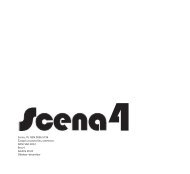
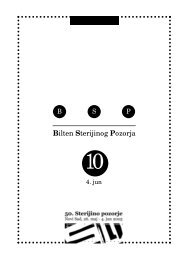
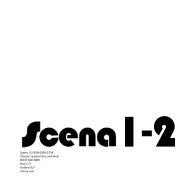

![neboj[a rom^evi] karolina nojber](https://img.yumpu.com/43476260/1/185x260/neboja-romevi-karolina-nojber.jpg?quality=85)
